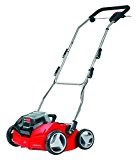Ride-on lawn mower purchasing advice: how to choose the right product
- What You Need to Know
- With a lawn tractor you can mow large areas efficiently and comfortably.
- Smaller ride-on mower models are worthwhile from about 600 square metres, from 2,000 square metres a lawn tractor makes sense in any case.
- Models with rear discharge usually have a catcher box, models with side discharge eject the grass to the side instead.
- Lawn tractors can be used in a variety of ways thanks to various accessories, such as for pushing snow or sweeping.
Lawn tractor: effortless mowing in a sitting position
For a perfectly manicured garden, a perfectly trimmed, lush green lawn with clear lawn edges bordering the flower bed or patio plays a paramount role. To keep the lawn looking its best, garden owners need to fertilise the greenery regularly, mulch it, keep pests away from it and, of course, mow it regularly. What can be done quickly on a small area in the front garden quickly becomes an unpopular drudgery in larger gardens. For such green areas it is advisable to use a lawn tractor.
Small areas: manual reel mower
The classic string trimmer is the scythe. However, nowadays only a few people have mastered the power-intensive manual mowing technique. Many owners of small garden plots have already used a manual lawn mower. These small devices are also called reel mowers. Lawn care is comparatively laborious with these. Users have to push the device and exert additional force to cut the blades of grass. If the lawn is too long, i.e. if it has not been mown for more than a week, cutting becomes cumbersome or even impossible. A manual cylinder mower of this type is suitable for a lawn area up to a maximum of 150 square metres.
Simplification with medium-sized areas: Electric and petrol mowers
Electric and petrol lawn mowers are a relief compared to manual cylinder mowers. They are particularly suitable for larger lawns of 150 square metres or more. Some models even have a forward drive so that users are spared the strenuous task of pushing the mower. All they have to do is walk behind the garden helpers, hold down the dead man’s switch and determine the direction by steering movements. This quickly becomes exhausting, especially on uneven garden surfaces. Gardeners can still manage gardens with areas of up to 1,000 square metres with these machines. These mowers scurry over lawns that would simply be too small or winding for lawn tractors. If this square metre figure is exceeded, green maintenance becomes too tedious and time-consuming. That’s when lawn tractors come into play.
Mowing large areas with ease: the lawn tractor
The best way is to use a lawn tractor. It makes it possible to mow large areas efficiently, quickly and with little effort, while sitting down. Simply sit up, start the machine and mow away. Quite a few people even enjoy gardening this way. Surely many garden owners have already dreamed of owning such a ride-on mower. With a cutting width of one metre, gardeners can work on a lawn of 1,000 square metres in about 20 minutes. Manually, for example with a push mower, the mowing process takes considerably longer.
Consequently, lawn care is easiest with ride-on mowers or lawn tractors. In the following, we will introduce both types, explain the differences and highlight for which purposes the machines are suitable.
Ride-on mower or lawn tractor?
There are differences between ride-on mowers and lawn tractors. Both are mowers that users operate in a seated position.
Older property owners of retirement age in particular benefit from the ability to maintain green areas while sitting down. But younger family members can often be persuaded to help out in the garden with the prospect of driving a ride-on lawn mower or lawn tractor.
In the following, we summarise the advantages of the two types over manual equipment and push mowers.
Pro points
- Less effort required
- Larger cutting widths
- Suitable for larger areas
- Working from a sitting position
- Larger cuttings collection
- Mowing less time-consuming
- Can be used with attachments as a snow plough, rotary snow plough, scarifier or sweeper
- Load transport with optional trailer
- Fun to drive
Drawbacks
- Higher purchase price
- Costly to maintain
- Not suitable for very sloping and narrow plots of land
- Often louder than hand mowers
- Class L driving licence required for some models.
- Subsequent mowing of verges necessary
- Damage to the paintwork possible due to low bushes
Ride-on lawn mower: the little brother of the lawn tractor
Ride-on mowers can be described as a small version of lawn tractors. They are characterised by a smaller design and high manoeuvrability. They are less powerful than lawn tractors. The smaller models are more manoeuvrable and also cheaper to buy, but they are also less powerful. In this version, the smaller, slimmed-down engine is located directly under the driver’s seat. Zero-turn or zero-turn mowers are particularly suitable for use on winding terrain. Ride-on lawn mowers are generally less universally applicable: fewer accessories are available for them than for large lawn tractors. Therefore, they are mainly suitable for medium-sized gardens with a lawn area between 800 and 2,000 square metres.
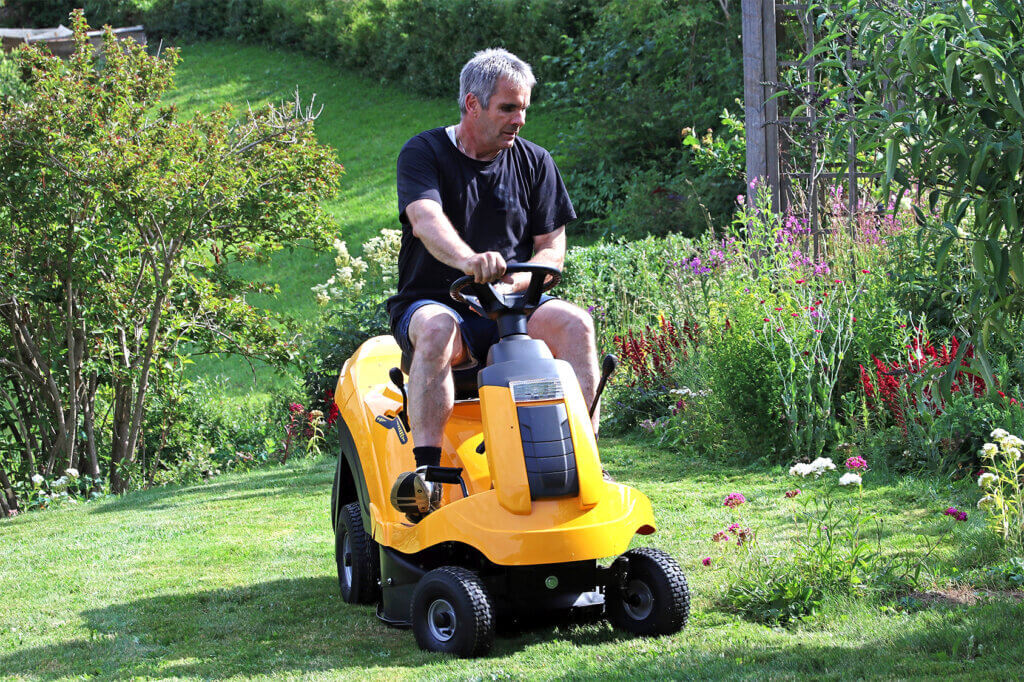
Lawn tractor: the efficient and powerful alternative
The more powerful alternative, which is particularly suitable for larger lawns, is the lawn tractor. With these machines, owners of larger gardens can mow their lawns efficiently, save time and without much effort. They are petrol or battery-powered ride-on machines that owners use to drive around the lawns to be mown. With lawn tractors, mobility is limited. The comparatively high performance potential is reflected in a higher purchase price. On the other hand, these machines can be used as snow clearing machines, snow blowers, sweepers or scarifiers. A hitch allows the machine to be towed by a trailer.
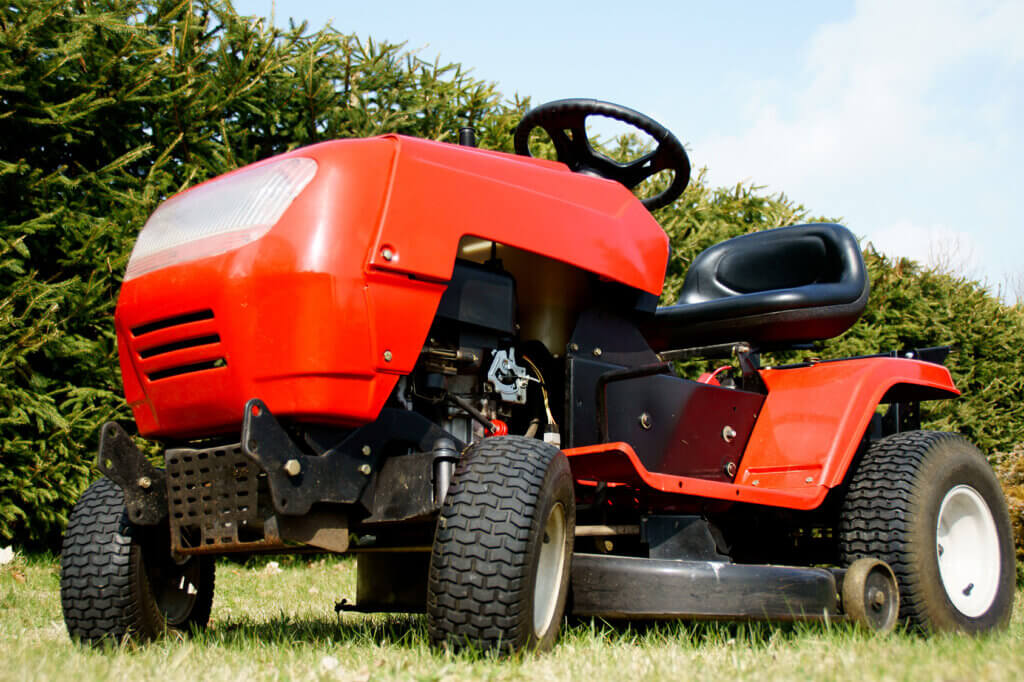
From what size of garden is a lawn tractor worthwhile?
Homeowners can still mow lawns up to about 600 or 800 square metres quite comfortably with a normal lawn mower that they push in front of them. If the lawn is approximately between 800 and 2,000 square metres, a small, manoeuvrable ride-on mower is recommended, which makes lawn care much easier and saves a lot of time when mowing. However, for properties exceeding 2,000 square metres, interested parties should go for the larger lawn tractors. These implements have a higher output and a greater cutting width. In this way, the total area is mown with fewer passes, which saves additional time.
However, private users are not recommended to blindly go for a very powerful mower model. While buying a powerful lawn is always a bit about prestige, buying an overpowered model can lead not only to a high purchase price but also to high follow-up costs, for example for inspections or repairs.
Finding the right lawn tractor
When looking for a suitable lawn tractor model, a lot of factors have to be taken into account in the decision-making process. We present the most important purchasing factors.
Cutting width
How many centimetres wide the cutting unit can mow determines how many lanes are needed to completely cover a plot of land, and thus also how long the mowing process will take. The larger the plot, the larger the cutting width should be. Very large cutting widths are not comfortable or efficient to work with a ride-on mower. Therefore, lawn tractors with correspondingly larger options are recommended for large plots of land. The following table gives an overview of different sized lawns and the resulting requirements.
| Extent of lawn area | Equipment type | Cutting width |
| 600–800 m² | Push mower or ride-on mower | 60–80 cm |
| 800–2.000 m² | Ride-on mower or lawn tractor | 80–100 cm |
| 2.000–3.500 m² | Lawn tractor | 100–110 cm |
| 3.500–5.000 m² | Lawn tractor | 110–120 cm |
| 5.000–8.000 m² | Lawn tractor | 120–130 cm |
| > 8.000 m² | Lawn tractor | > 130 cm |
Disadvantage of the large implements: In angled gardens, grass residues always remain at lawn edges or in corners that are difficult to access, which users then have to rework with a push mower or with a trimmer. It should be noted that it is not only the size of the lawn that is decisive, but also whether it is a free and level area or whether slopes, flower beds, trees, paths or obstacles complicate the mowing process.
Petrol or battery engine
There are both petrol and battery-powered electric lawn tractors on the market. Both have specific advantages and disadvantages. However, petrol-powered models are still clearly in the majority. Depending on the fuel tank, petrol-powered models have a longer running time and can be used at any time. On the other hand, fuel and maintenance costs are higher and have a greater impact on the environment. The battery-powered mower, on the other hand, is environmentally friendly thanks to its zero emissions, is inexpensive to operate and has a low noise level. The disadvantages are the limited running time and the forced breaks during recharging of the batteries. Another decisive factor is whether the lawn is right next to the house or whether there is a journey to be made first, which has an impact on fuel consumption and battery life.
Rear-wheel or all-wheel drive
Many lawn tractor models have rear-wheel drive. This is perfectly adequate for a large number of planned applications. However, if you have to deal with uneven and steep surfaces on your property, a model with all-wheel drive is recommended. This guarantees extensive off-road capability, so that you will not encounter any problems when mowing such areas.
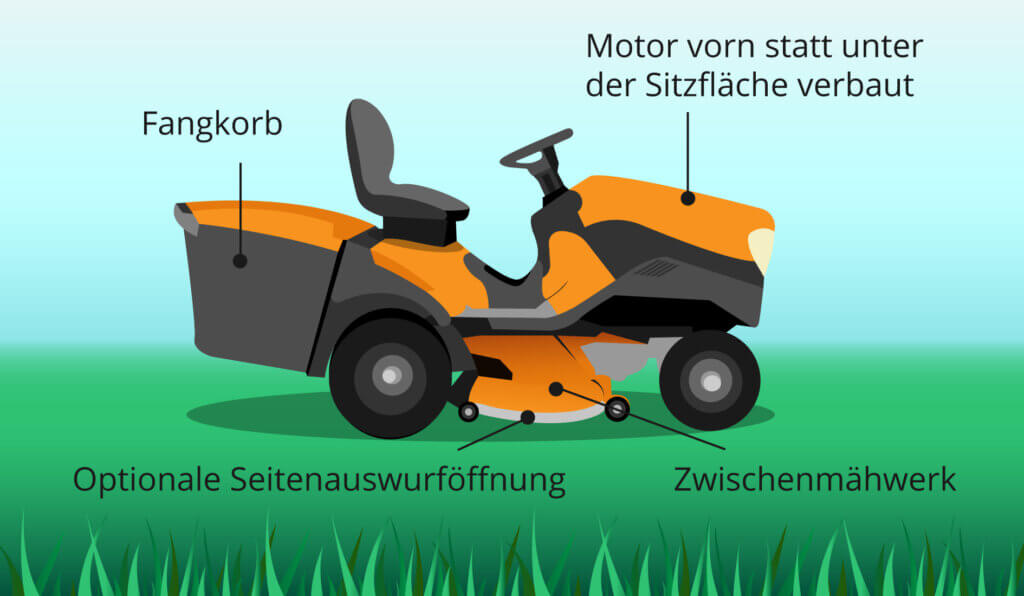
Transmission
Riding mowers or lawn tractors usually have one of the following three types of transmission.
- Transmatic transmission
- Hydrostatic transmission
- Automatic transmission
Transmatic transmissions allow uninterrupted propulsion even at different speeds. The gardener selects the desired speed via a lever on the dashboard. He does not accelerate as he would in a car, because the mower drives on its own. When the driver steps on a pedal, it merely brakes, and when he takes his foot off the pedal, the mower resumes the preset speed. Hydrostatic transmissions provide infinitely variable speed control. Shifting and clutching are no longer necessary. Automatic transmissions are mainly known in the passenger car sector. There is no need to change gears manually; the driver selects the speed steplessly via the accelerator pedal.
Front or intermediate mower
Whether you should choose a lawn tractor model with a front or intermediate mower depends on the size and condition of your garden and the type of lawn you have sown. A front mower is recommended if your property has a lot of angled areas and bushes. Tall grass can be kept short as well as trimmed with a high cutting height. It is therefore possible to leave grass higher if desired.
Intermediate mowers are best suited for large, exposed lawns. The cutting height is limited at the top, as the grass clippings are driven over with the mower mounted under the lawn tractor. It is well suited for use on play or ornamental lawns. Such mowers are used, for example, on football pitches or for maintaining the English lawn in parks. But of course, devices with an intermediate mower are also suitable for home lawns.
Mowing methods: lawn ejection and mulching function
On lawn tractors, the discharge chute for the clippings can be located either at the rear or on the side. In the case of rear discharge, the mown greenery is usually transported directly into a catcher box, which you have to empty from time to time, depending on the maximum filling volume. This achieves a clean cut, which is what most garden owners want. It is possible to mow wet ground with both the rear and side discharge. The advantage of a rear discharge is that an additional fan is installed to transport clippings into the catcher bag.
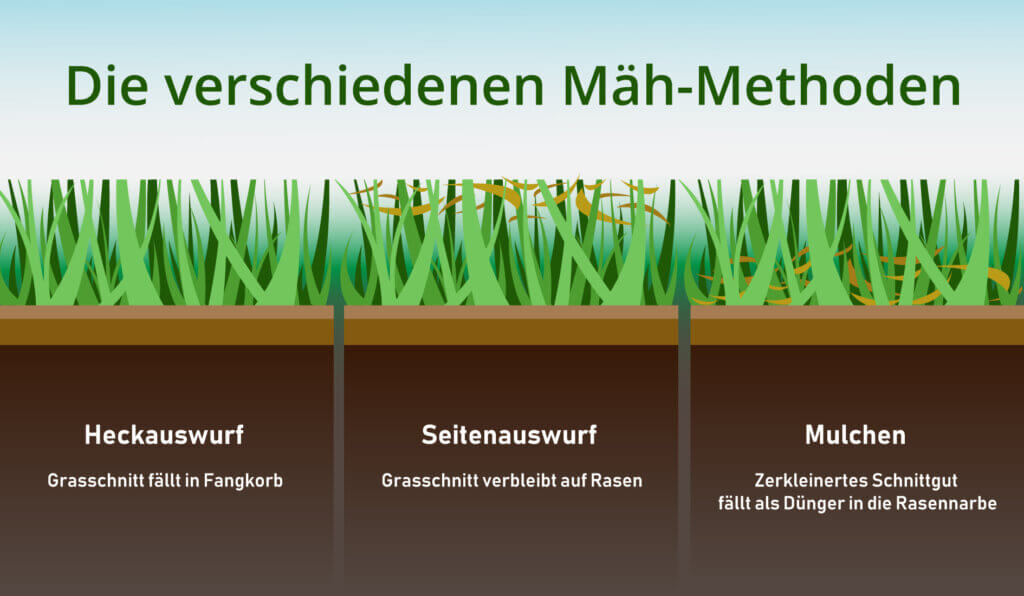
With side discharge, the green cuttings are discharged at the side and distributed over the lawn area. However, this method does not do justice to the visual ideal of a well-kept ornamental lawn. Such models are more suitable for large garden areas where appearance is not important. On some ride-on mower models with side discharge, you can retrofit special catch baskets and mowing decks.
If you want a neat appearance but do not want to collect the cuttings or do not want to collect them in a catcher box, a lawn tractor with mulching function is recommended. During the mulching process, the blades of grass that have already been cut are chopped up, hit several times by the cutting unit and in this way thrown deeper down to the sward. After the cut grass has settled for a few hours, there is practically nothing left to be seen of the clippings. However, this method requires regular mowing. Regular here means: Once a week, or more frequently if the lawn is growing fast.
Volume of grass clippings
The larger the catcher box, the less often you have to interrupt mowing to empty it. Depending on the size of the tractor, the catcher box can have different volumes. Containers with a capacity of 100, 150, 200 or 240 litres are common. In addition, emptying the catcher box on lawn tractors with rear discharge is often conveniently possible from the seat.
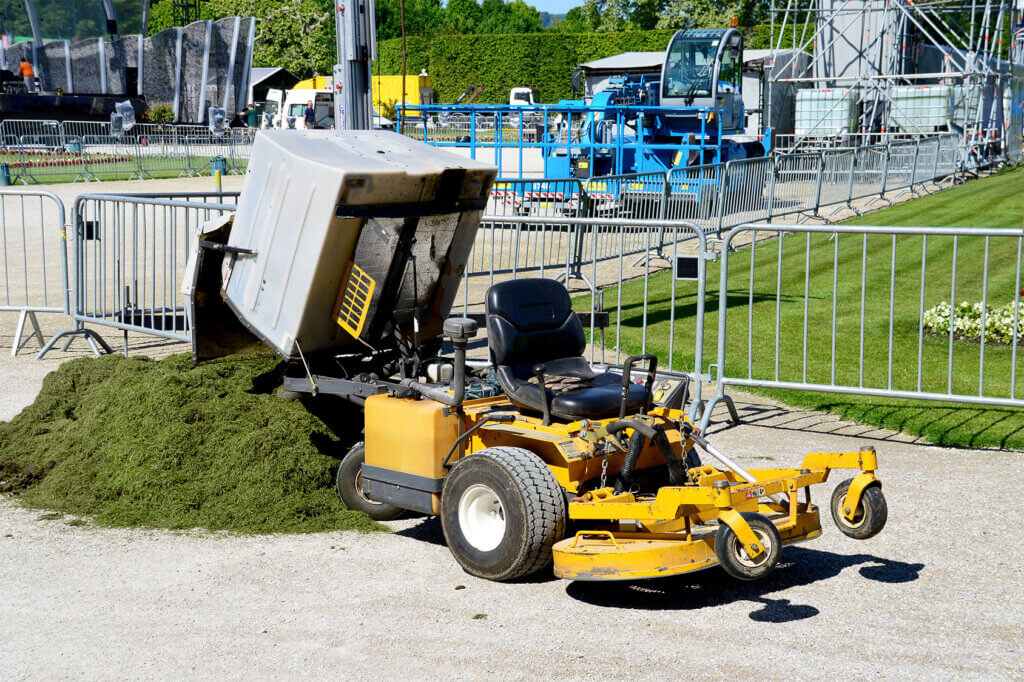
Fuel tank capacity
The size of the fuel tank determines how long you can mow without having to take a break to refuel. On virtually all tractors, the tank is large enough to mow a lawn several times without stopping to refuel. With small ride-on mower models or when working in a park with a very large lawn area, it can happen that you run out of fuel. Therefore, pay attention to the number of square metres specified by the manufacturer that can be mowed with one tank of fuel.
Battery power
If you decide to buy an electric ride-on lawnmower, it is important to pay attention to the battery’s running time in mowing mode. You can also find this information from the manufacturer or on the seller’s website.
Other features
In addition to the basic specifications of a lawn tractor that best suits your needs, there are several optional add-ons and features that can help determine your purchase decision. These include electric starting, comfortable seat adjustment, lighting and various accessories.
Electric start
Ride-on mowers and lawn tractors are usually equipped with an electric starter. Users then start the equipment either by turning the ignition key, as in a car, or by pressing a start button.
Comfort and seating position
Tall people should pay particular attention to the fact that the seating position can be adjusted individually. This is not only for comfort, but also for safety when driving the vehicle.
Headlights
If you work at dusk or in the dark, headlights are indispensable. A swivelling spotlight is particularly convenient and safe, so that you can always see everything from the side of the implement. Of course, this is especially true during the cold season. Then there is no lawn to mow, but you can do other work with the right accessories. When using multifunctional accessories such as the snow blower, proper lighting is a prerequisite. Headlights are definitely required if you plan to participate in public road traffic with the device. The headlights require special road traffic approval for this purpose. For information on whether a tractor may be moved outside private property, please refer to the owner’s manual.
Multifunctional accessories
Gardeners and hobby gardeners can expand their lawn tractor into a multifunctional tool by adding various accessories. This may be the case with a sweeper attachment, which you can also use to keep your driveway and yard clean. In winter, a snow blade helps to clear snow from roads, driveways and car parks. A snow blower can also cope with larger masses of snow.
When using it as a transport device, you are usually not bound to original accessories. The couplings for trailers are mostly standardised. You can therefore purchase various accessories. However, pay attention to the maximum permissible load and the maximum drawbar load.
Wheelbase
For properties with a slope, it is advisable to use a lawn tractor with a large wheelbase. The steeper the slope, the larger the wheelbase should be in order to master driving the vehicle and mowing the lawn even under these conditions.
Hints for use
The most important thing when gardening is safety. In addition, regular maintenance and care ensure that you will have fun with your large gardening machine for a long time.
Is a driving licence necessary for lawn tractors?
Generally, a driving licence is only required for ride-on mowers or lawn tractors that can drive faster than six kilometres per hour. This does not apply to most machines. Such implements, which do not require a driving licence, may be driven by young people over the age of 15. If the machine in question can go faster, however, drivers need a Class L driving licence, which applies to all forestry and agricultural equipment. This licence can be obtained from the age of 16. It requires 14 hours of theory, but no practical training. As long as the equipment does not leave private property, this licence is not necessary either. However, users should be familiar with the operation.
Safety instructions
To ensure safe use of a lawn tractor, you should first familiarise yourself with the operating instructions after purchase. A test drive on level ground is then advisable.
Children and animals should not be in the direct vicinity of the working machine because of the risk of accidents. Caution is advised when mowing off-road. Mowing slopes with a gradient of more than 20 percent is not permitted with most models. The risk of rollover is too great, and the rotating blades in particular, which sweep onto the top, could lead to serious injuries.
Do I need a lawn tractor with a roll bar?
If you want to mow a rough plot with a steep slope, it is advisable to buy a lawn tractor model with a roll bar. This safety feature can also be retrofitted on some models. It protects against serious injuries when the mower tips over.
Cleaning
If possible, you should clean the catcher box and the mower after each use. Follow the safety instructions here as well to prevent the engine from accidentally restarting. There is a great risk of injury. Wear gloves to avoid cuts. Use running water to remove wet grass residues. Make sure that neither oil nor fuel gets into the environment. Never use a high-pressure cleaner.
Tip
Use a lawn tractor lift for cleaning and maintenance. This makes it easier and more convenient to reach all components. You can obtain such a device in retail shops as well as in various online shops.
Maintenance
Here, too, the operating instructions will tell you at what intervals minor maintenance work is necessary. It will tell you at what intervals the engine oil, air filter or spark plug needs to be changed. The tractor should also be parked in a dry place to prevent corrosion. Most lawn tractor owners do not use their garden equipment in winter. If this is the case for you, empty the petrol tank at the end of the season and run the carburettor empty. Otherwise, the fuel loses its ignition capacity, which can lead to problems when starting the engine in spring.
Fuel consumption & follow-up costs
Fuel consumption depends on the size and horsepower of the engine. Almost all lawn tractors can be fuelled with super petrol. Some models also tolerate the somewhat cheaper E10 fuel. In addition to these consumption costs, you have to factor in further expenses for consumables such as engine oil, spark plugs or air filters. Regular maintenance is worthwhile, however: clogged air filters increase fuel consumption, which leads to rising follow-up costs due to more frequent refuelling. Insufficient oil pressure can seriously damage the engine.

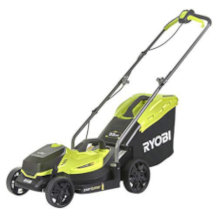
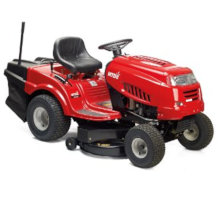
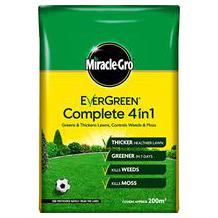
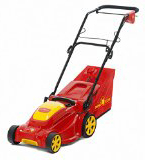

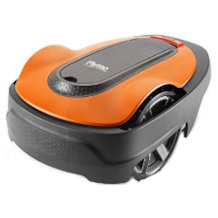
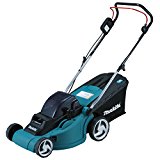
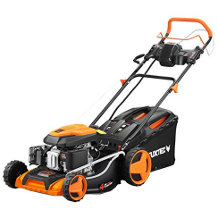


 2 reviews
2 reviews
